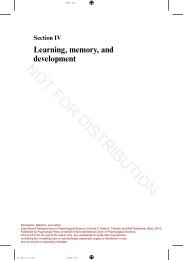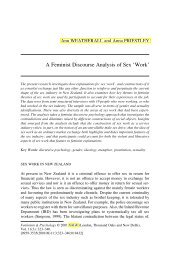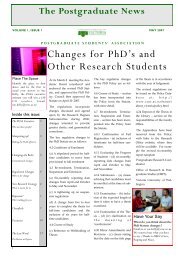green & myerson 2004.. - of /courses
green & myerson 2004.. - of /courses
green & myerson 2004.. - of /courses
Create successful ePaper yourself
Turn your PDF publications into a flip-book with our unique Google optimized e-Paper software.
Green and Myerson Page 6 <strong>of</strong> 48<br />
NIH-PA Author Manuscript NIH-PA Author Manuscript NIH-PA Author Manuscript<br />
expression A d /(1 + D/m) q/r . This is equivalent to Equation 3 with k = 1/m and s = qlr (Myerson<br />
& Green, 1995). Thus, both Equations 2 and 3 are consistent with the view that choices between<br />
rewards available at different times are really choices between different rates <strong>of</strong> reward.<br />
Rachlin et al. (1991) developed a psychophysical procedure to evaluate empirically different<br />
discounting equations. An example <strong>of</strong> this type <strong>of</strong> procedure is shown in Figure 5. In the<br />
example, participants choose between hypothetical monetary rewards: a small amount <strong>of</strong><br />
money available immediately and a larger amount available after a delay (e.g., $150 now vs.<br />
$1,000 in 6 months). If they choose the delayed reward, then the amount <strong>of</strong> the immediate<br />
reward is increased (e.g., $200 now), and they are asked to choose again. This process is<br />
repeated until the immediate reward is preferred to the delayed reward. To control for order<br />
effects, the point at which preference reverses is redetermined, this time beginning with an<br />
amount <strong>of</strong> the immediate reward similar to that <strong>of</strong> the delayed reward so that the immediate<br />
reward is preferred. The amount <strong>of</strong> immediate reward is then successively decreased until the<br />
delayed reward is preferred. The average <strong>of</strong> the two amounts at which preference reversed is<br />
taken as an estimate <strong>of</strong> the subjective value <strong>of</strong> the delayed reward (i.e., the amount <strong>of</strong> an<br />
immediate reward that is judged equal in value to the delayed reward).<br />
To map out a discounting function, subjective value is estimated at a number <strong>of</strong> different delays.<br />
Figure 6 shows representative data (group medians) for delayed hypothetical $10,000 rewards<br />
obtained by Green, Fry, and Myerson (1994) using this psychophysical method and<br />
subsequently fit with different equations by Myerson and Green (1995). As may be seen, the<br />
exponential (Equation 1; dashed curve) provided the poorest fit, systematically overpredicting<br />
the subjective values at briefer delays and under-predicting the subjective values at longer<br />
delays. The hyperbola (Equation 2; dashed-and-dotted curve) provided a much better fit,<br />
although it, too, tended to systematically overpredict the subjective values at briefer delays and<br />
underpredict the subjective values at longer delays.<br />
The finding that temporal discounting is better described by a hyperbola than by an exponential<br />
has been replicated in study after study (e.g., Green, Myerson, & McFadden, 1997; Kirby,<br />
1997; Kirby & Maraković, 1995; Kirby & Santiesteban, 2003; Rachlin et al., 1991; Simpson<br />
& Vuchinich, 2000). Although the difference in the proportion <strong>of</strong> variance accounted for (R 2 )<br />
is small in some <strong>of</strong> these studies (e.g., Kirby & Maraković, 1995), it should be noted that in<br />
others the difference in the proportion <strong>of</strong> variance accounted for is substantial. In Figure 6, for<br />
example, the exponential (Equation 1) accounts for 81.5% <strong>of</strong> the variance, whereas the<br />
hyperbola (Equation 2) accounts for 93.7% (for another particularly striking example, see<br />
Rachlin et al., 1991, Figure 7).<br />
It can be seen that Equation 3 (solid curve) provided the best fit to the data in Figure 6 (R 2 = .<br />
977). It is well known, <strong>of</strong> course, that simply adding a free parameter to a model tends to<br />
increase the proportion <strong>of</strong> variance accounted for. Therefore, to make the case that Equation<br />
3 provides a better model <strong>of</strong> discounting, one must take into account considerations in addition<br />
to the increase in the value <strong>of</strong> R 2 relative to a simple hyperbola or exponential function. One<br />
<strong>of</strong> the most fundamental <strong>of</strong> these considerations is whether the differences in the proportion<br />
<strong>of</strong> variance accounted for are statistically significant. This question may be addressed by using<br />
a statistical approach analogous to the comparison <strong>of</strong> linear regression models. That is, one<br />
may compare a reduced model (a hyperbola without the exponent parameter) with a full model<br />
(one that includes the exponent parameter).<br />
With respect to the group median data depicted in Figure 6, Myerson and Green (1995) reported<br />
that adding an exponent produced a statistically significant increase in the proportion <strong>of</strong><br />
variance accounted for. This finding has subsequently been replicated in further studies from<br />
Psychol Bull. Author manuscript; available in PMC 2006 February 24.






